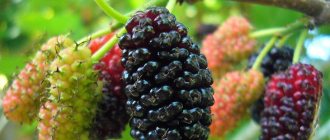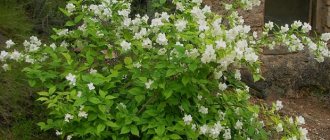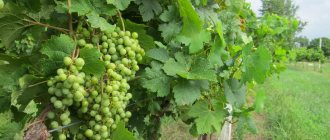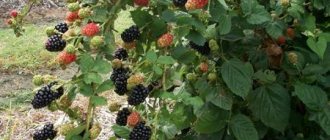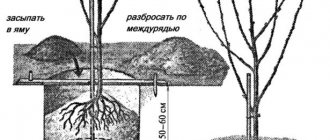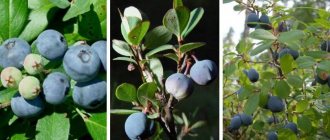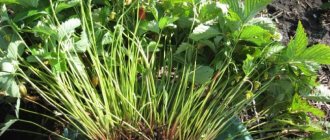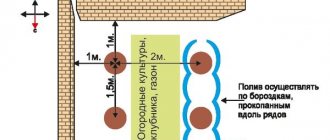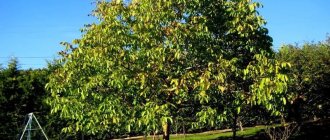Varieties
Despite the wide variety of varieties, blackberries are divided into 3 main types:
- bramble or upright;
- dewberry or creeping;
- semi-creeping.
These are all blackberries, but each type has its own distinctive characteristics:
- Kumanika - branches grow straight, more than 200 cm long. The stems are powerful, thorny, the tops are often bent in an arc. This species is characterized by good resistance to frosty winters. The average weight of berries is about 4 g. They are propagated by root suckers, which are produced in sufficient quantities.
- Dewberry - has long shoots up to 5 m long that spread along the ground. The branches are heavily covered with thorns. It is characterized by high yield and large fruit, the weight of the berry is about 12 g. This species reproduces well in the shade, is resistant to drought, but does not tolerate frost well. Without insulation, the bushes will die in winter. Propagated by cuttings from replacement shoots, or rather by their tips.
- Semi-creeping is an average type, at first the branches grow straight, then over time they bend and creep along the ground. The shoots are very long, up to 6 m, without thorns. The berries have an average weight of about 6 g. They are propagated by root suckers and by rooting the tips of replacement shoots. In mild frosts it overwinters well; in severe winters it requires shelter.
But all this is a characteristic of the species. As for varieties, they may not exactly match their species.
SELECTING AN AREA FOR PLANTING BLACKBERRY
Blackberry is a heat-loving and slightly winter-hardy plant.
In the middle zone, the optimal planting time is spring. The site should have a low groundwater table (2 m or more) and be well lit. The plant tolerates slight shading. Therefore, it can be planted near fruit trees with restrained growth and a small crown size. Blackberries are less demanding on soil fertility than raspberries, but they produce good yields with a high level of agricultural technology on light soils rich in organic matter.
Poorly drained carbonate (limestone) soils and soils with high acidity and excess moisture are considered unsuitable for growing blackberries. The reaction of the soil solution should be slightly acidic or neutral (pH 6.5-7).
The best varieties to grow
To grow blackberries in the Urals, you should choose varieties that are resistant to frosty winters and have a mid-early or mid-ripening period. Late varieties will not have time to ripen; very early varieties may have flowers that freeze during spring frosts. It is also worth giving preference to upright types of blackberries, as they are more resistant to harsh winters.
Find out what blackberries on your site are incompatible with.
The following varieties received the best reviews from gardeners in the Urals:
- Early ones - Eldorado, Snyder, Polar.
- Average - Gazda, Lawton, Thornfree.
- Late - Texas, Oregon Thornless.
- Winter-hardy - Agavam, Giant, Darrow, Amara, Ruben.
A brief description of each blackberry variety:
- Eldorado is an upright growing bush with many small, soft thorns. The productivity is high, the fruits are large, the ripening period is early. Frost resistance is mediocre. Requires insulation for the winter;
- Snyder is an upright, thorny bush. It is noted for its high yield, early ripening period, good winter hardiness and resistance to fungal diseases. The berries are not very large, with a pleasant sweet and sour taste;
- Polar - bushes with erect stems, without thorns. Productivity is good. The berries are sweet and fragrant. Winter hardiness is high. Does not like waterlogged soil;
- Gazda is a tall bush with slightly thorny shoots. The fruits are large, with dense pulp, and have a sweet and sour taste. Tolerates cold temperatures well, but needs a sufficiently lit planting site;
- Lawton is an upright growing bush, the shoots are strongly thorny, and the thorns are hard. Productivity is high. The fruits are sweet with a sour note. Does not tolerate low temperatures well and requires bending of stems and shelter for the winter;
- Thornfree is a bush with semi-creeping, strong shoots. Absolutely no thorns. Fruiting is high, extended. The berries are large, sweet and sour taste. Winter hardiness is average, winter insulation is necessary;
- Texas - belongs to the type of dewberry, the shoots are long, strongly thorny, spreading along the ground. The variety is noted for large fruits and high yield. The berries are sweet, with a pleasant sour note. Requires insulation for the winter;
- Oregon Thornless - creeping shoots, without thorns. Large-fruited and high-yielding variety. Berries with excellent taste and aroma. Frost resistance is average, requires shelter for the winter;
- Agave - the variety belongs to the brambles, has tall, powerful and heavily thorny shoots. The yield is good, the berries are of medium size. The variety is noted for its high frost resistance and has good immunity to diseases. Tolerates dry periods well and can bear fruit in the shade;
- The giant is a tall bush, with powerful flexible branches, without thorns. The productivity is very high. The berries are large, conical in shape, with a pronounced blackberry flavor. Frost resistance is high, but it does not tolerate drought well;
- Darrow is an upright growing bush. Shoots with small soft thorns. Productivity is high. The berries are medium-sized, with a sweet and sour dessert taste. Winter hardiness is high;
- Amara is a remontant new variety. Tall bush with straight, thornless shoots. The yield is high, the berries are large, with a dessert blackberry taste and aroma. Winter hardiness is good, since most of the shoots are removed for the winter, and only the root needs to be insulated;
- Ruben is a remontant variety. The bushes are tall, with straight-growing powerful branches, covered with thorns that fall off after fruiting. The berries are large, sweet and sour. The yield is average, the variety bears fruit twice per season.
These are the most popular blackberry varieties, but every year breeders delight gardeners with new, improved fruits of their activity.
Selection of frost-resistant blackberry varieties for the Urals
Frost-resistant blackberry varieties for the Urals tolerate low temperatures well. The most popular types are:
- Abundant;
- Ufa;
- Polar;
- Arapaho;
- Apache.
Izobilnaya is a variety characterized by powerful bushes without root suckers. Semi-creeping shoots are completely covered with spines, bent inward. The fruits have an oblong shape and are small in size. They taste sweet, with a slight sourness. This variety is well suited for the Urals, as it tolerates severe frosts well.
Ufimskaya is a variety with small berries weighing about 3 g. The fruits have a pleasant taste. The bushes are characterized by high productivity - up to 12 kg of fruit can be collected from one bush.
Polar is a variety with strong stems that do not have thorns. The berries are large, their weight is 9-11 g. This plant tolerates frosts down to -30°C without shelter. If you cover blackberries for the winter, you can get a richer harvest in the summer.
Arapaho is a non-thorny variety with juicy berries that weigh 6-7 g. The yield from one bush is above average. This plant practically does not get sick and tolerates frosts down to -25°C without protection.
Apache - the variety is distinguished by strong vertical shoots without thorns. The berries are cylindrical in shape and large in size. Can be stored for a long time. Blackberries are characterized by high productivity, increased frost resistance and rarely get sick.
Specifics of agricultural technology
When growing garden blackberries in the harsh climate of the Urals, you need to adhere to the basic rules:
- It is necessary to correctly select and prepare a place for planting.
- Know the disembarkation dates.
- Choose good planting material.
- Provide proper care for the bush.
Armed with the necessary knowledge, you will provide yourself with a constant harvest, healthy bushes and minimal work on caring for the plant.
Did you know? Modern varieties produce a harvest of more than 30 kg per bush per season.
Deadlines
Experienced gardeners recommend planting young trees in the Urals exclusively in early spring, in the first half of May. This gives plants a better chance of successful rooting. But if for some reason spring planting is impossible, then seedlings can be planted in the first ten days of September.
Site selection, site preparation
For good fruiting, blackberries need sunlight, they do not like cold winds, moisture should not stagnate, the groundwater level can be at least 1.5 m. The area for planting blackberries can be slightly sloping, the soil has good drainage.
The site must be prepared in advance. Clear it of weeds and their roots, dig deep. Blackberries need soil with neutral acidity; in alkaline and high pH soils, they develop poorly, so during preparation you need to equalize the acidity of the soil. Add fertilizer to weak soils. Ideally, blackberry bushes bear fruit on loam or sandy soils.
Selection of planting material, how to prepare
Of course, if there are already blackberry bushes on the site, then there will be no problems with planting material. But if this is the first planting, then the selection of material must be taken seriously. It is recommended to buy seedlings only from trusted sellers; it is better to do this in specialized nurseries and farms, as they grow varietal blackberries appropriate to the region, treated against diseases and pests.
Important! Annual seedlings take root better.
This way, there is a greater chance of purchasing exactly the variety that you have chosen for your garden, and there is less chance of bringing a diseased plant onto the site.
Saplings are suitable if:
- They are powerful, strong, resilient.
- They have well branched roots.
- They have at least two shoots with a diameter of about 3–5 mm.
- A bud has already formed near the roots.
The roots should be moist; if they are dry, they should be immersed in water for 3–5 hours. Instead of water, you can use a solution with a growth stimulator.
Do blackberries grow in the Urals?
Many gardeners are interested in the possibility of planting blackberries in the Urals. The Urals are characterized by a harsh climate with severe frosts, cold winds and few sunny days. To get the best results in growing this berry, you must first choose a variety. For the climatic conditions of the Urals, varieties that are frost-resistant and adapt to sudden temperature changes are suitable. It is necessary to choose a variety that will have time to produce a harvest before the onset of frost.
High-quality crop care will help the plant grow and ripen under the unfavorable weather conditions of this region.
Landing algorithm
The planting scheme is quite simple. Blackberries can be planted either in individual bushes, if these are single bushes, or in rows, if a large planting is planned.
To plant correctly, you need to follow the following instructions:
- First you need to dig holes measuring 50x50 cm. The distance between seedlings of upright growing species should be at least 100 cm, for creeping species - at least 200 cm. Between rows - more than 150 cm.
- Then prepare the planting substrate - mix the soil from the holes with humus (8-10 kg), add superphosphate (150-200 g), potassium salt (50-70 g), mix everything thoroughly.
- Next, fill the holes more than halfway, water, and let the water soak into the ground.
- Place the seedling vertically, straighten the roots well (they should not stick out), sprinkle with a nutrient mixture.
- Sprinkle a fertile layer of soil on top and compact it well. The root bud should be about 5 cm underground.
- Make a circle around the trunk and water it.
- Apply mulch approximately 5–7 cm thick. For this, peat, straw, sawdust, etc. are used.
- The seedlings are trimmed, leaving 5–10 cm of the total length.
After planting and pruning, it is recommended to treat the plants with Bordeaux mixture.
Features of planting and growing
To grow a crop and harvest a good harvest from it, it is necessary to provide it with quality care.
Optimal timing
It is recommended to carry out planting work in early spring. This helps to avoid freezing of young crops.
Site selection and soil preparation
Blackberries need sunny areas. It is important to ensure that it is not exposed to wind or drafts. It is recommended to plant bushes near the fence. This will provide them with the support they need.
In spring, blackberries are planted in the spring, before the buds appear. To achieve good results, it is worth using fertile and drained soil. Loam or sandy soils are excellent options.
See also
Characteristics and description of Thornfree blackberries, cultivation and care
Read
Acidity parameters are also important. For blackberries, a pH value of 6-6.2 would be ideal. In conditions of high humidity, the bush will not be able to fully develop and will begin to lag in growth. This will negatively affect the future harvest.
It is forbidden to plant blackberries in carbonate soil. Such soil is characterized by a deficiency of iron and magnesium. Subsequently, this will provoke the development of leaf chlorosis.
Landing technology
To grow a crop, it is worth making a depression of 40-50 centimeters. It is recommended to mix the soil with superphosphate, compost and potash. Then the bush is placed in the hole and the root system is straightened. It should be sprinkled with prepared soil on top.
It is worth maintaining a certain interval between bushes. It should be 0.7-1.5 meters. It is recommended to use support structures.
Rules of care
In order for a blackberry planting to please you with a good harvest and healthy bushes, you need to take care of it. The first year, the bushes need to be well watered so that the ground under the bush is moist, but without stagnant water. Once established, plants are watered only when the soil dries out during particularly dry periods. This is about once a week. During the ripening period, regular watering is required.
Also read about the best way to replant blackberries in the spring.
To develop, the roots need access to oxygen, so the soil under the bushes needs to be loosened. This must be done once every two weeks, not very deeply. For the first 2–3 years, blackberries do not need feeding. Then nitrogen fertilizing is applied. In case of weak soils, in the spring, fertilize the soil with compost or humus every year at the rate of 7–8 kg per square meter. Potassium additives without chlorine (20–30 g) and superphosphate (100–150 g) are applied in the fall (calculated per bush).
It is also necessary to remove weeds, as they can spread diseases. This is done by weeding between the rows and bushes. To reduce the number of waterings, loosening and weeding of the soil, the ground under the bush needs to be mulched. Peat, sawdust, and straw are suitable for this. This will not only make caring for the plant easier, but will also prevent the roots from drying out.
Growing blackberries in the Urals: care and planting
To obtain good results in growing blackberries, in addition to the correctly selected variety, it is necessary to provide the plants with proper care in compliance with the rules of agricultural cultivation in the unfavorable climatic conditions of the Urals.
When choosing a site, importance is given to predecessors. It is recommended to plant the crop after field grasses, legumes, and cereals. Blackberries should not be planted after tomatoes, peppers, or potatoes.
When is the best time to plant
In the Urals, seedlings are planted only in early spring. If you plant seedlings in the fall, the immature plants will not have time to take root before the onset of cold weather and will freeze in winter. Blackberries begin to be planted before the buds begin to bloom.
Selecting a location
For planting blackberries, choose well-lit, sunny places. The crop does not react well to wind and drafts, so choose an area protected from the north wind. In the shade of tall trees or buildings, the bushes will develop poorly, stretch out, and the harvest will be weak. The best place for planting will be an area near a house or fence; this will later serve as a support for the shoots. When planting plants, retreat 1 m from the future support so as not to darken the bushes. It is advisable to plant the crop on the south or south-west side of the site.
When choosing a site, be sure to take into account the depth of groundwater. If the distance to the water level is less than 1.5 m, the root system will be constantly in wet soil. In winter, this will lead to freezing of the roots.
Soil preparation
For spring planting, the soil begins to be prepared in the fall. Over the winter, all the added substances will saturate the soil well and it will be ready for spring planting.
Attention! Blackberries will not grow in marshy, rocky, or sandy areas.
To begin with, the area is dug up deeply, and all plant debris is removed, pulling out their roots from the soil. Then the soil is mixed with compost or manure to enrich the soil with nutrients.
Dry leaves and chopped branches are added to the soil as future drainage.
It is necessary to take into account the acidity of the soil. If the site has acidic soil, lime is added to it; if there is alkaline soil, iron sulfate is added at the rate of 0.5 kg of the drug per 10 sq.m of land.
Along with organic matter, complex mineral fertilizers are also added to the soil. After this, thoroughly mix and level the soil, water and cover with mulch.
How to plant correctly
Planting pits are prepared 2 weeks before planting seedlings. Dig holes 40 cm deep and wide.
Reference! A distance of 1 m is left between upright bushes, and 1.5 m between creeping bushes.
A distance of 2 m is maintained between rows.
Fertilizers are added to each planting hole:
- compost or humus – 4 kg;
- superphosphate – 100 g;
- potassium sulfate – 50 g.
Nutrients are mixed with soil and the hole is filled 2/3 full.
The bush is placed vertically in the hole, the roots are carefully leveled. The root collar is deepened by 1.5-2 cm. Then soil is added and watered. A layer of mulch is placed around the bush.
How to care for blackberries
Caring for blackberries grown in the Urals requires compliance with the rules of agricultural technology used in difficult climatic conditions.
in spring
The planted plant requires regular watering, using a moderate amount of liquid. Drying out the soil and excessive moisture has a detrimental effect on the root system.
Great importance is attached to loosening the soil. It is necessary to provide air access to the roots.
In the spring after planting, the plant needs nitrogen fertilizing for better growth. For this purpose, urea is used. For watering at the root, prepare the following composition: 30 g of urea, 10 liters of water.
Organic matter is added by loosening the soil with humus and compost.
Important ! It is not allowed to use fresh manure or droppings for feeding; they burn the roots. The organic matter must first rot.
During the fruiting period, the plant needs potassium. It is necessary to improve the taste of berries. It is applied by fertilizing with potassium sulfate or potassium nitrate at the rate of 50 g per 10 liters of water. Alternate with fertilizing with a solution of wood ash: 200 g of ash per 10 liters of water. In total, 4 potassium feedings are carried out during the summer.
Pruning and shaping the bush
Blackberry bushes require regular pruning. The exception is first-year plants. There is no need to trim them, but if they bloom, the flowers should be completely torn off. Next spring, shoots are pinched to 10–15 cm. In summer, damaged and dried shoots are removed.
Important! You need to remove old branches to the very roots, without leaving stumps, as they will rot and harm the health of the bush.
After harvesting, it is necessary to remove fruiting and diseased branches at the root. Excessive root shoots and weak green shoots are removed. After autumn pruning, only young strong branches should remain in the amount of 7–9 pieces. In early spring, frozen stems are removed. Healthy stems are trimmed, leaving 150 cm in length.
How to care
Caring for blackberries grown in the Urals requires following some simple rules.
Loosening and watering
To obtain a rich harvest, you will need to regularly loosen the soil. Thanks to it, the water will not stagnate, and the roots will receive the necessary dose of oxygen. Watering should be regular but moderate. It is important to prevent the soil from drying out, but standing water also has a detrimental effect on the bushes.
On the video - how to properly care for:
Shaping bushes
Like raspberries, blackberries begin to produce their first fruits the very next year. It is at this time that the bushes will need to be molded and tied up. The following options can be used as supports:
- Arched or fan . These products are to be installed in the middle of the bush. They will straighten the shoots upward and horizontally.
Flat trellises. All shoots will be laid on one side. In this case, fruits on young shoots can be seen in a year.
- Supports may be concentrated along the rows of bushes . This option is considered the most convenient.
When shaping, for the bushes to grow fully, it is necessary to separate the fruiting stems from the young and replacement shoots. But you can understand how to care for garden blackberries by looking at the contents of this article.
Trimming
In the first year of crop growth, it should not be pruned. The only thing you can touch is the inflorescences. This will allow the plants to take root securely. The tips of the shoots that have frozen after winter must also be removed.
Already, starting from the second year, in the spring, trim the stems to a length of 1.5 m. In this way, you can get lush flowering and increase productivity. In early summer, thin out the bushes that have produced many shoots. You will have to cut out very young shoots, leaving the stronger ones. It's also worth reading about whether you need to prune your blackberries.
Trellis installation diagram, garter
Whatever the type of blackberry, the bushes must be tied up. This will make it easier to care for the plant and when harvesting. The garter will also protect the branches from bending under the weight of the berries and breaking. The most effective method of supporting shrubs is trellises. To do this, high strong posts or pipes are driven along the length of the row at a distance of 5–7 m, wire is attached to them in three rows, to which branches are tied.
Learn how to make your own blackberry trellis.
There is no need to attach plants of the first year; it is enough to direct them to a support. You can tie bushes to stakes. This can be done in a bun or a fan. For the first method, a tall, strong peg is driven into the middle of the bush, and all the branches of the bush are attached to it. For the second method, stakes are driven in near the bushes. Half of the branches from two bushes growing nearby are tied to them.
Variety selection criteria
For regions with harsh climatic conditions, varieties that can withstand severe temperature drops are suitable.
In this case, the fruits must have time to ripen before the arrival of cold weather. The ability of the bushes to withstand strong winds is of no small importance. For the Urals, the best option would be upright varieties of blackberries, which are resistant to temperature fluctuations. These include plant varieties such as Waldo and Kiowa. The Black Satin variety is also suitable.
Harvesting and storage
Despite the fact that blackberry fruits stick well to the bush and do not fall off after full ripening, it is still necessary to choose the optimal time for harvesting. In some varieties, overripe berries lose their taste, the pulp becomes soft, which reduces the shelf life of fresh berries. You need to collect dark purple dense fruits. This should be done in dry weather so that the berries are not wet.
You need to pick the berries carefully, along with the stalks. The harvested crop must be removed from the sun and placed in a cool place. You can use plastic containers with a volume of 2–3 kg. Don't fill it tightly. After picking, sort the fruits, crushed ones can be processed, and moldy berries can be thrown away. There is no need to wash the entire crop before storing it, otherwise the fruits will drain and quickly deteriorate. Before freezing, the berries should be soaked briefly in cold water and dried on a paper or cloth napkin.
We advise you to find out the benefits and harms of blackberries.
Separate from the stalks. Spread in a thin layer on a board, cardboard or tray and place in the freezer. After freezing the berries, they are packaged in separate containers or plastic bags based on the number of berries required for one use, since they cannot be frozen again. Then they are sent back to the freezer. This is done with all other crops intended for freezing.
Blackberries make excellent preserves, compotes, and jams. To preserve its beneficial properties, you can grind it with sugar, and for longer storage, such blackberries can be frozen. It also does not lose its properties and is stored for a long time in dried form. The shelf life of fresh blackberries depends on the characteristics of the variety; the berries can be stored for up to 20 days on the bottom shelves of the refrigerator or in the basement.
Shelf life in different states:
- Frozen and dried blackberries can be stored for 36 months;
- grated with sugar - refrigerated for 3-4 months;
- the same only in the freezer - 12–16 months;
- jams, compotes - 24 months.
Video: making blackberry compote
Further care
To get a strong and powerful plant, you need to provide it with high-quality and complete care.
It is worth watering the plant systematically, but it is recommended to use a moderate amount of liquid. It is important to ensure that the soil does not dry out. At the same time, standing water also has a negative effect on the bushes.
Fertilizer
In the spring, blackberries require the use of nitrogen fertilizers. This component is present in urea. It is also worth adding a bucket of humus or compost. This is done at intervals of 2 years.
Support garter
The blackberry vine is long. At the same time, the berry clusters often hang down, weighing down the bush. Therefore, plants need a trellis. The most common option is a flat support. In this case, the vine is usually tied in a fan fashion.
It is best to make a trellis at arm's length. The bottom wire should be placed 1 meter from the ground. This will keep your brushes from touching the ground.
Crown formation
In the first year the plant does not need pruning. This will ensure high-quality rooting of the culture. At the same time, it is worth getting rid of inflorescences and frozen ends of shoots.
From the second year, the branches should be pruned, giving them a length of 1.5 meters. Thanks to this, it will be possible to achieve abundant flowering and increase productivity. At the beginning of summer, bushes that produce a large number of shoots should be thinned out. It is recommended to remove young branches, leaving the most powerful ones.
Even hybrid varieties of blackberries, which are characterized by excellent frost resistance, are capable of freezing. To avoid this, it is recommended to cover the plant in the fall. To do this, you should dig a trench and place young branches in it. They should be covered with sawdust or pine needles on top. In spring, it is recommended to remove the covering material. This is done before the buds appear.
Blackberries are a popular plant that can be grown even in the harsh climate of the Urals. To achieve excellent results, first of all, it is necessary to correctly select a resistant variety. In addition, it is recommended to carry out planting work correctly and select adequate care.
Preparing for winter, how to cover
It is necessary to prepare the bushes for winter immediately after harvesting:
- The branches are carefully pruned.
- Old mulch, branches, leaves, berries, weeds are removed from the ground and all this is destroyed.
- The soil is loosened, fertilizers are applied if necessary, a tree trunk is made, and watered.
- Apply a new thick layer of mulch. Spray with Bordeaux mixture and carefully remove the branches from the trellis.
- It is necessary to put something under the branches so that they do not break under the weight of the shelter.
- In upright growing varieties, the branches can be tied into a bundle and bent down gradually.
- It is necessary to cover strictly at a stable sub-zero temperature.
Important! You need to open the bushes in time to avoid fogging.
For covering, you can use special covering materials, film, straw, hay, sawdust, peat, etc.
Video: two ways to cover blackberry seedlings
Reproduction methods
As mentioned above, straight-growing varieties are propagated by root suckers. Creeping blackberries reproduce using the tips of replacement shoots. Semi-creeping - in both of these ways. Blackberries can also be propagated by seeds and by dividing the mother bush.
But the seed method does not guarantee the safety of the blackberry variety, and when dividing the bush it takes a long time to take root, so we will highlight the two most effective and simple methods:
- Root suckers form near the roots. In early spring, they are carefully separated from the selected bush and transferred, along with part of the soil, to a new planting site. They must be young, strong, thick, at least 1 cm thick and 15 cm long. The root system is well branched, the roots should be 20 cm in length.
- To propagate green tops in the spring, before the beginning of the growing season, it is necessary to cut off strong annual shoots, leaving two buds on the mother bush. Cut cuttings from these blanks; they should contain part of the stem, one bud and one leaf. The lower part of such a cutting should be soaked in a solution with a preparation to stimulate the growth of the root system for 5–6 hours. During this time, prepare the planting mixture and containers. The mixture is peat and sand mixed in equal parts. Paper or plastic cups with holes made at the bottom or film envelopes are used as planting containers. The planting containers are filled with the mixture, the cuttings are placed there and the seedlings are sent to the greenhouse. It maintains an air temperature of about +25°C, 100% air humidity and 80–90% soil humidity. After 30–40 days, the seedlings can be transplanted to a permanent location.
- These two methods of growing blackberries have a number of advantages:
- Variety preservation guarantee.
- Avoiding plant contamination.
- Economical.
Diseases and pests
To prevent the blackberry planting from getting sick and being attacked by pests, it should be placed away from garden strawberries and raspberries, since they have the same diseases, and blackberries themselves get sick less often. It is also necessary to adhere to the rules of agricultural technology, prevent waterlogging of the soil, get rid of weeds, loosen the soil and thin out the bushes.
Find out how to deal with blackberry diseases and pests.
Blackberries are affected by viral and fungal diseases:
- With the virus, the leaf blades acquire variegated colors.
- When a fungal infection occurs, various spots appear on the leaves and branches.
Fungicides are used to prevent and control fungal infections. The plant is treated with these chemicals after harvesting, before covering the bush for the winter and in the spring, before the start of the plant’s life processes - this is prevention. When a lesion is detected, they also treat the diseased plant and the ground around it. It is strictly forbidden to spray plants with anything during flowering.
Aphids on blackberries. You can use biological drugs or traditional methods of control. Unfortunately, if a bush is damaged by a virus, it cannot be saved. It is worth uprooting it without regret and destroying it outside the farm. Don’t forget about harmful insects, because they carry viral infections. Blackberries are most often attacked by aphids. If you notice its appearance on the shoots, they need to be carefully cut off and burned.
Did you know? The easiest way to protect a plant from harm is to pour boiling water from a watering can on the branches and the ground underneath them in early spring, before the bushes awaken. Then cover the soil under the bush with dense material.
For prevention, bushes are treated with insecticides. When mites are detected, they first feed on young shoots, then they infect flowers and fruits, they become deformed and, without ripening, crumble. To combat ticks, special preparations are used - acaricides.
Varieties for Bashkiria
The same varieties are suitable for Bashkiria as for growing in the Urals.
You can add several of the most popular varieties with a brief description:
- Triple Crown - powerful bushes, growing strongly. The shoots are creeping, without thorns. The ripening period is early. The berries are large, juicy, with a pleasant taste and a plum-cherry aftertaste. Productivity is average. The pulp is dense, the harvested crop can be transported;
- Loch Ness - compact bushes, with semi-creeping long shoots, without thorns. The berries are sweet and sour with a pleasant blackberry aroma. Productivity is high. The pulp has a dense consistency, which allows the crop to be transported over long distances;
- Arapaho is an early ripening variety. Bushes with erect stems, thornless. The fruits are large and sweet. Productivity is average. Resistant to diseases and pests.
As you can see, blackberries can be grown anywhere. Yes, in a cold climate the yield will be reduced, but this is not a reason to refuse to enjoy this delicious, healthy berry grown with your own hands. It is less whimsical than other fruit and berry crops. You just need to insulate the planting in time, and you are guaranteed a harvest.
Description of thornless blackberry varieties
Blackberries have undergone a number of changes with cultivation. What is characteristic of garden berries is that:
- It has a compact or creeping bush shape with shoots reaching a length of 1.5 to 4 meters, smooth, without thorns.
- A powerful branched root system helps the crop quickly adapt to new conditions.
- Small openwork leaves are located on short petioles.
- The flowers are white or pink and have a diameter of about 2 centimeters.
- The berries, similar in structure to raspberries, have a large white stalk with black or dark red drupes.
Some thornless varieties are resistant to low temperatures, while others require shelter for the winter. Regular climbing blackberries take 2 years to develop. First, when young shoots grow, fruit buds are formed. Then they give berries and then the old fruit ones are cut out. Remontant types of crops without thorns can produce berries on both new and old branches.
